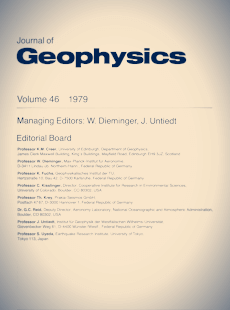Bursts of irregular magnetic pulsations during the substorm
Article Sidebar

Vols. 1-18 (1924-1944), ISSN 0044-2801
Main Article Content
Abstract
New characteristics of PiB magnetic pulsations which are associated with the substorm in the local midnight sector are revealed from the recordings of a meridional network of ground stations. PiB's are observed during distortions of the auroral arc which enclose a local region of upward directed field-aligned current. An enhancement at about 0.3–0.4 Hz is shown to be a permanent feature of PiB's. In addition, a secondary amplitude maximum at about 1 Hz sometimes appears in the recordings far from the auroral zone. The generation of PiB pulsations in the Pi1 period range is located at auroral latitudes at a low altitude. Low-altitude electric fields and acceleration of auroral particles, low-altitude resonance cavities, and isotropic propagation of waves is discussed in the interpretation of PiB pulsations.
 ARK: https://n2t.net/ark:/88439/y043502
ARK: https://n2t.net/ark:/88439/y043502
Permalink: https://geophysicsjournal.com/article/287
Article Details
References
Block, L. (1978) A double layer review. Astrophys. Space Sci. SS:59-83
Carlqvist, P. (1972) On the formation of double layers in plasmas. Cosmic Electrodynamics 3:377-388
Coleman, P.J., McPherron, R.L. (1976) Substorm observations of magnetic perturbations and ULF waves at synchronous orbit by A TS-I and A TS-6. In: Knott and Battrick (Eds.) The Scientific Satellite Programme during the International Magnetospheric Study, pp. 345-365. D. Reidel Publ. Co., Dordrecht-Holland
Davis, T.N. (1978) Observed characteristics of auroral forms. Space Sci. Rev. 22:77-113
Frank, L.A., Ackerson, K.L. (1971) Observations of charged particle precipitation into the auroral zone. J. Geophys. Res. 76:3612-3643
Heacock, R.R. (1967) Two subtypes of type Pi micropulsations. J. Geophys. Res. 72:3905-3917
Heacock, R.R., Hunsucker, R.D. (1977) A study of concurrent magnetic field and particle precipitation pulsations, 0.005 to 0.5 Hz, recorded near College, Alaska. J. Atmos. Terr. Phys. 39:487-501
Lanzerotti, L.J., Fukunishi, H. (1974) Modes of magnetohydrodynamic waves in the magnetosphere. Rev. Geophys. Space Phys. 12:724-729
Nishida, A. (1964) Theory of irregular magnetic micropulsations associated with a magnetic bay. J. Geophys. Res. 69:947-954
Nishida, A. (1978) Geomagnetic diagnosis of the Magnetosphere. Springer, Berlin-Heidelberg-New York
Petelski, E.F., Fahleson, U., Shawhan, S.D. (1978) Models for quasi-periodic electric fields and associated electron precipitation in the auroral zone. J. Geophys. Res. 83:2489-2498
Potemra, T.A. (1978) Observation of Birkeland currents with the Triad satellite. Astrophys. Space Sci. 58:207-226
Quang, B.H., Wong, A.Y. (1976) Formation of potential double layers in plasmas. Phys. Rev. Lett. 37:1393-1396
Saito, T. (1969) Geomagnetic pulsations. Space Sci. Rev. 10:319-412
Saito, T., Sakurai, T., Koyama, Y. (1976) Mechanism of association between Pi2 pulsation and magnetospheric substorm. J. Atmos. Terr. Phys. 38:1265-1277
Stuart, W.F. (1974) A mechanism of selective enhancement of Pi2's by the plasmasphere. J. Atmos. Terr. Phys. 36:851-859
Swift, D.W. (1978) Mechanisms for the discrete aurora. A review. Space Sci. Rev. 22:35-75
Torven, S., Babic, M. (1975) Current chopping space charge layers in a low pressure arc plasma. In: Proc. 12th International Conference on Phenomena in ionized gases. American Elsevier Publ. Co., New York
Torven, S., Andersson, D. (1978) Observations of electric double layers in a magnetized plasma column. TRIT A-EPP-78-12. Royal Institute of Technology, Stockholm
Untiedt, J., Pellinen, R., Kuppers, F., Opgenoorth, H.J., Pelster, W.D., Baumjohann, W., Ranta, H., Kangas, J., Czechowsky, P., Heikkila, W.J. (1978) Observations of the initial development of an auroral and magnetic substorm at magnetic midnight. J. Geophys. 45:41-65











